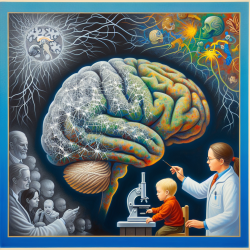Introduction
In the realm of speech-language pathology, particularly when addressing language impairments in children, data-driven insights are invaluable. Recent research, such as "The white matter connectome as an individualized biomarker of language impairment in temporal lobe epilepsy," offers profound implications for improving therapeutic outcomes. This study not only broadens our understanding of language impairments in temporal lobe epilepsy (TLE) but also highlights the potential of the white matter connectome as a predictive tool.
Understanding the Research
The study explores how the structural connectome (SC) can serve as a more precise biomarker for language impairments compared to traditional clinical variables and global white matter tract measures. Utilizing diffusion MRI, the research team constructed a robust SC model that outperformed other models in predicting language impairment in TLE patients. This model achieved a higher area under the curve (AUC) and accuracy, emphasizing the SC's superior predictive capability.
Key Findings
- The SC-model yielded an AUC of 0.73 and an accuracy of 79%, surpassing the tract-model and CV-model.
- Lateral temporal connections, particularly those similar to language association tracts, were crucial to the SC-model's performance.
- The SC approach captured a distributed, bilateral network, highlighting the complexity of language impairments in TLE.
Implications for Practitioners
For practitioners, these findings underscore the importance of adopting a network-based approach to understand language impairments better. By focusing on the SC, practitioners can gain a nuanced view of the microstructural alterations that contribute to language deficits. This approach not only aids in more accurate diagnosis but also informs targeted interventions that can be tailored to the individual needs of children with TLE.
Encouraging Further Research
While the study offers promising insights, it also opens avenues for further research. Practitioners and researchers are encouraged to explore the SC's applicability across different clinical populations and its potential integration into routine clinical assessments. Additionally, expanding the sample size and diversity in future studies will enhance the generalizability of these findings.
Conclusion
The integration of the white matter connectome into clinical practice represents a significant advancement in the field of speech-language pathology. By leveraging this innovative approach, practitioners can improve diagnostic accuracy and therapeutic outcomes for children with language impairments. As we continue to explore the intricacies of the brain's network, the potential for transformative impacts on child development becomes increasingly tangible.
To read the original research paper, please follow this link: The white matter connectome as an individualized biomarker of language impairment in temporal lobe epilepsy.










